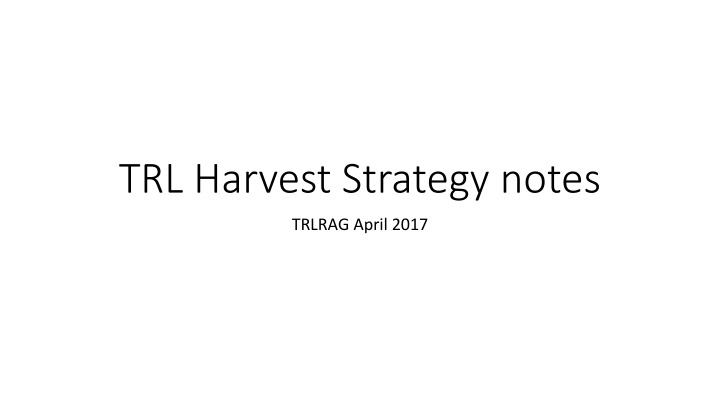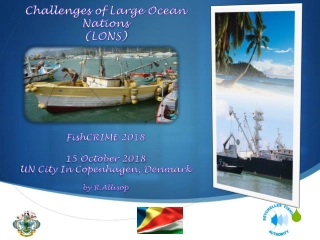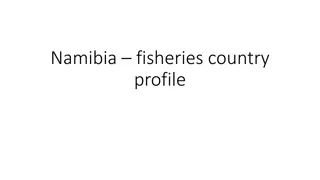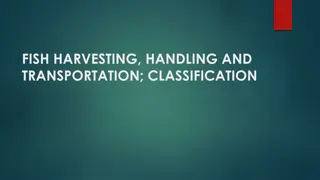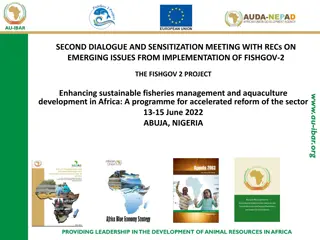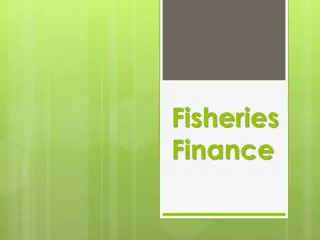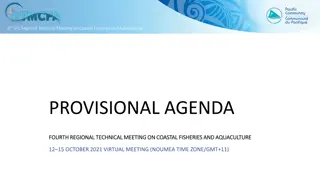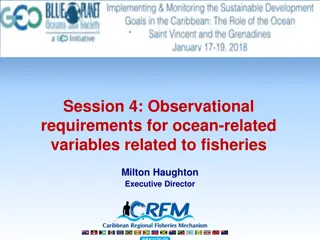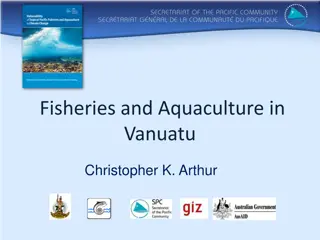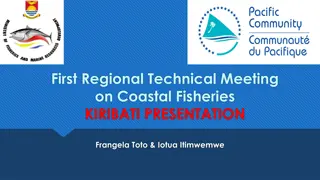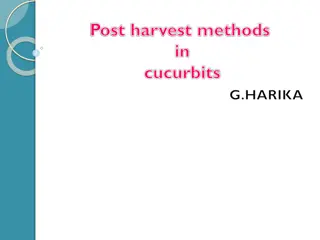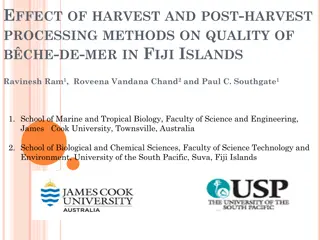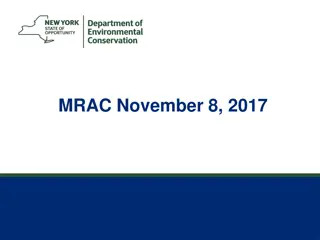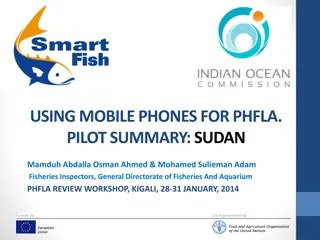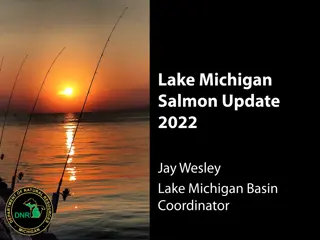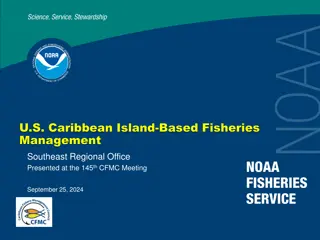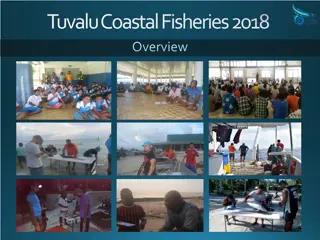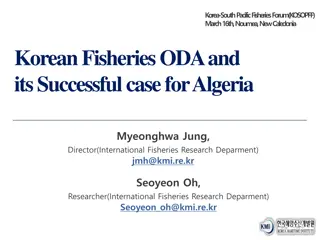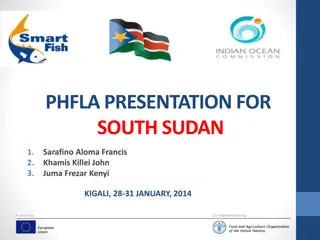Effective Harvest Strategy Implementation for Sustainable Fisheries Management
The Harvest Strategy Framework prioritizes maximum economic yield and stakeholder-preferred biomass levels to guide fishing activities. It involves key reference points such as target biomass (BTARG) and limit biomass (BLIM) to maintain stock sustainability. Closure rules and subsequent actions are crucial for monitoring stock levels, with emphasis on surveys for accurate assessments. The strategy also highlights specific timings for actions, like preseason surveys in November. Overall, the emphasis is on maintaining stock levels for long-term sustainability and social considerations.
Download Presentation

Please find below an Image/Link to download the presentation.
The content on the website is provided AS IS for your information and personal use only. It may not be sold, licensed, or shared on other websites without obtaining consent from the author.If you encounter any issues during the download, it is possible that the publisher has removed the file from their server.
You are allowed to download the files provided on this website for personal or commercial use, subject to the condition that they are used lawfully. All files are the property of their respective owners.
The content on the website is provided AS IS for your information and personal use only. It may not be sold, licensed, or shared on other websites without obtaining consent from the author.
E N D
Presentation Transcript
TRL Harvest Strategy notes TRLRAG April 2017
Reference Point justification OVERVIEW The HSF uses maximum economic yield as a target and a biomass limit reference point to trigger no further targeted fishing Suggest replacing wording with uses a stakeholder-agreed economically and socially preferable level as a target or similar.. 2.7 Ref Points The target biomass BTARGis the spawning biomass level which would maintain the stock at a recent average level favoured by stakeholders as satisfying biological, economic and social objectives, and is the proxy for BMEY, BTARG= 0.65 B0.
HS reference points The unfished biomass B0is the model-estimate of spawning stock biomass in 1973 (start of the Fishery). B0= B1973. The target biomass BTARGis the spawning biomass level which would maintain the stock at a recent average level favoured by stakeholders as satisfying biological, economic and social objectives, and is the proxy for BMEY, BTARG= 0.65 B0. The RAG noted a higher target biomass than the HSP policy default was considered important for the Fishery because: 1) the stock: is a shared resource that is particularly important for traditional fishing; 2) the stock has high variability; and, 3) all industry members recommended the HS maintain the stock around the relatively high current levels (RAG meeting no. 17, 31 March 2016 and meeting no. 18, 2-3 August 2016). The limit biomass BLIMis the spawning biomass level below which the risk to the stock is unacceptably high and the stock is defined as overfished . BLIMis agreed to be half of BTARG, BLIM= 0.32 B0. If the limit reference point (BLIM) is triggered two years out of the most recent three year period, then the Fishery is closed. The target fishing mortality rate FTARGis the estimated level of fishing mortality rate that maintains the spawning biomass around BTARG. FTARG= 0.15. FTARG= 0.15 is assumed to be a proxy for FMEYbecause stakeholders agreed that this target level corresponded to an optimal level in terms of economic, biological and social considerations (RAG meeting no. 18, 2-3 August 2016)
Closure rule & subsequent action If the integrated stock assessment determines the stock to be below the biomass limit reference point in two successive years the Fishery is closed to commercial fishing. The Fishery can only open when a survey has been conducted and the integrated stock assessment determines the Fishery to be above the biomass limit reference point. The next Should we clarify here that this is based on additional survey information ?
Notes Timing re when actions happen ? Change season timing Preseason survey in November so check survey trigger end Nov
2.2 Objectives draft version The operational objectives of the Harvest Strategy are to: maintain the stock at (on average), or return to, a target biomass point BTARGequal to the stock size that aims to maximise net economic returns for the Fishery by maintaining the stock abundance around recent levels while having regard for the fact that the resource is shared and important for the traditional way of life and livelihood of traditional inhabitants; maintain stocks above the limit biomass level (BLIM), or an appropriate proxy, at least 90 per cent of the time; and implement rebuilding strategies, if the stock moves below BLIM in successive years.
2.2 Objectives - proposed The operational objectives of the Harvest Strategy are to: maintain the stock at (on average), or return to, a target biomass point BTARGequal to recent levels (2005-2015) that take account of the fact that the resource is shared and important for the traditional way of life and livelihood of traditional inhabitants and is biologically and economically acceptable; The agreed BTARG is more precautionary than the default proxy BMEY (biomass at maximum economic yield) level as outlined in the HSP policy maintain stocks above the limit biomass level (BLIM), or an appropriate proxy, at least 90 per cent of the time; The agreed BLIM is more precautionary than the default proxy HSP BLIM Implement rebuilding strategies, if the spawning stock biomass is assessed to fall below BLIM in two successive years.
